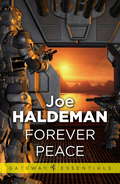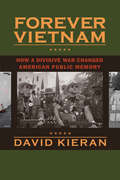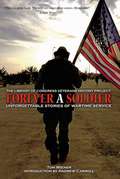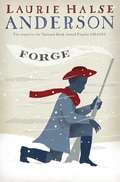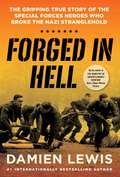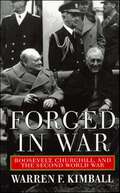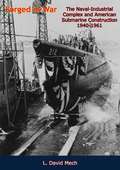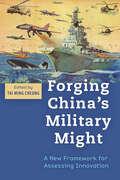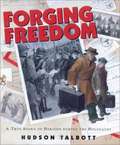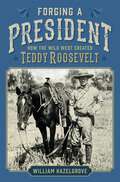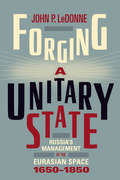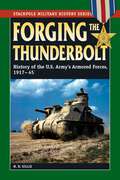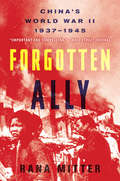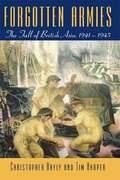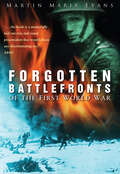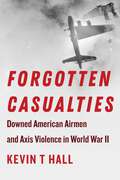- Table View
- List View
Forever Peace: Forever War Book 2 (FOREVER WAR)
by Joe HaldemanIn the year 2043, the Ngumi War rages. Limited nuclear strikes have been used on Atlanta and two enemy cities, but the war goes on, fought by 'soldierboys' - indestructible war machines operated by remote control by soldiers hundreds of miles away.Julian Class is one of these soldiers, and for him war is truly hell. The psychological strain of being jacked-in to his soldierboy - and the genocidal results - are becoming too much to bear. Now he and his companion, Dr Amelia Harding, have made a terrifying scientific discovery, which could literally take the universe back to square one. Except that for Julian, the discovery isn't so much terrifying as tempting...Winner of the Hugo Award for best novel, 1998Winner of the Nebula Award for best novel, 1998Winner of the John W. Campbell Award for best novel, 1998
Forever Vietnam: How a Divisive War Changed American Public Memory
by David KieranFour decades after its end, the American war in Vietnam still haunts the nation’s collective memory. Its lessons, real and imagined, continue to shape government policies and military strategies, while the divisions it spawned infect domestic politics and fuel the so-called culture wars. In Forever Vietnam, David Kieran shows how the contested memory of the Vietnam War has affected the commemoration of other events, and how those acts of remembrance have influenced postwar debates over the conduct and consequences of American foreign policy. Kieran focuses his analysis on the recent remembrance of six events, three of which occurred before the Vietnam War and three after it ended. The first group includes the siege of the Alamo in 1836, the incarceration of Union troops at Andersonville during the Civil War, and the experience of American combat troops during World War II. The second comprises the 1993 U.S. intervention in Somalia, the crash of United Airlines Flight 93 on September 11, 2001, and the Iraq and Afghanistan wars. In each case a range of actors—military veterans, policymakers, memorial planners, and the general public—used memorial practices associated with the Vietnam War to reinterpret the contemporary significance of past events. A PBS program about Andersonville sought to cultivate a sense of national responsibility for the My Lai massacre. A group of Vietnam veterans occupied the Alamo in 1985, seeing themselves as patriotic heirs to another lost cause. A World War II veteran published a memoir in 1980 that reads like a narrative of combat in Vietnam. Through these and other examples, Forever Vietnam reveals not only the persistence of the past in public memory but also its malleability in the service of the political present.
Forever a Soldier: Unforgettable Stories of Wartime Service
by Tom WienerForever a Soldier captures the personal side of war in 37 extraordinary narratives that bear eloquent witness to both the life-changing experience of battle and to the unflagging spirit that sustained countless ordinary Americans plunged into the bloody conflicts of the deadliest, most destructive century in human history. Culled from letters, diaries, private memoirs, and oral histories collected by the Library of Congress Veterans History Project, their stories paint an unforgettable group portrait of our country's armed forces. <P><P>Some tell of frontline action: a doughboy's 1918 baptism of fire: a battleship gunner's grim duel with Japanese planes; a female fighter pilot's capture by Iraqis during the Gulf War. Others evoke moments of relief and reflection, or recall deeply moving episodes: two wounded soldiers—one German, one American—clasping hands in the wordless brotherhood of pain; a POW whose faith gave him the strength to endure torture in the notorious "Hanoi Hilton;" a GI's lifelong grief for a buddy killed on the last day of World War II in Europe. <P><P>Forever a Soldier presents famous incidents like the sinking of the USS Indianapolis and her survivors' terrifying ordeal in the shark-infested Pacific, and heroic figures like John McCain, but it's the long-untold stories of unheralded patriots that best reveal the universal truths of war: courage and fear, horror and exhilaration, sorrow and triumph—the shared legacy of every American veteran, and a debt of honor the rest of us must respect but can never repay.
Forge (The Seeds of America Trilogy #2)
by Laurie Halse Anderson&“One of the best novels they have ever read.&” —Kirkus Reviews Curzon navigates the dangers of being a runaway slave in this keenly felt second novel in in the historical middle grade The Seeds of America trilogy from acclaimed author Laurie Halse Anderson.Blistering winds. Bitter cold. And the hope of a new future. The Patriot Army was shaped and strengthened by the desperate circumstances of the Valley Forge winter. This is where Curzon the boy becomes Curzon the young man. In addition to the hardships of soldiering, he lives with the fear of discovery, for he is an escaped slave passing for free. And then there is Isabel, who is also at Valley Forge—against her will. She and Curzon have to sort out the tangled threads of their friendship while figuring out what stands between the two of them and true freedom.
Forged By War: Australian Veterans in Combat and Back Home
by Gina LennoxIn Forged By War, Australian veterans and their families reveal the experience of combat and how it has changed their lives. These stark first-hand accounts describe the reality of military action and its personal consequences in every major conflict and peacemaking mission since World War II, including the invasion of Iraq. Sometimes the reader is in lockstep with a soldier on patrol, watching as a land mine explodes, or a local militiaman points an AK–47 at Australian peacemakers. Other times, the reader is inside a returned veteran's head, feeling their superfluous adrenalin, their need to control their environment, even at home. With accounts from Peter and Lynne Cosgrove, Graham Edwards, Frank Hunt (I Was Only Nineteen), other veterans of Vietnam, Glenda Humes (daughter of Capt Reginald Saunders), peacemakers and an SAS trooper, this compelling investigation by Gina Lennox in underpinned by the question: where does family fit in a soldier's life?
Forged in Chaos: A Warrior's Origin Story
by Tyler Grey Lauren UngeldiForged in chaos, shattered in peace: What happens when the war doesn&’t end, it just moves inside your head?Tyler Grey was the epitome of the warrior archetype: a Delta Force operator, a master of counterterrorism. He hunted the worst bullies on the world&’s playground—high-value targets, bomb makers, warlords—executing covert missions that never made the news. He had perfected the persona—ruthless, efficient, untouchable—until one mission in Sadr City, Iraq changed everything.&” On what should&’ve been a routine raid, an explosion ripped through the home shattering more than just flesh and bone; it fractured his identity. Stripped of everything that defined him, Tyler reached for chaos: sex, substances, a romance that was either a love worth fighting for or his ultimate kryptonite. But beneath it all, the hunger for chaos never died. He was built for it. Without it, his body rebelled, his mind fractured, and the war turned inward. In this raw, antiheroic tale, Tyler dissects his life, exposing the unseen war within and exploring the question: What happens when the very abilities that made you a superhero in the eyes of the world turn you into a supervillain in your own life? Despite rising PTSD awareness, we&’re losing more warriors at home than in war. Such a devastating reality begs the question: What if we&’ve fundamentally misunderstood this disease? This book doesn&’t challenge the narrative; it destroys it, laying bare the cost of being forged in chaos. This isn&’t a war story. It isn&’t a tribute to sacrifice or a highlight reel of heroics. Forged in Chaos rips the mask off the warrior experience, exposing the truth that most never dare to face: The fight isn&’t over. And this time, the enemy isn&’t out there—it&’s within.
Forged in Fire (Star Trek)
by Andy Mangels Michael A. MartinAN UNTOLD TALE OF STAR TREK ® HISTORY REVEALED AT LAST. A vicious pirate known as the Albino is cutting a deadly swath across space, creating turmoil in the Klingon Empire that threatens to spill into the Federation. But this criminal also has a secret that could shake the halls of Imperial power, and his genocidal plans against the race that bore him will have consequences even he cannot imagine, as several unlikely allies join swords to bring the Albino to justice: Hikaru Sulu of the U.S.S. Excelsior; Klingon captains Kor, Koloth, and Kang; and a hotheaded young Federation diplomat named Curzon Dax. Tempered in the flames of their shared adversity, a captaincy is forged, a Blood Oath is sworn...and a hunt begins that will stretch from one generation to the next.
Forged in Hell: The Gripping True Story of the Special Forces Heroes Who Broke the Nazi Stranglehold
by Damien LewisCombining riveting combat writing with masterful research, award-winning historian and #1 internationally bestselling author Damien Lewis delivers the remarkable true story of Britain&’s infamous, elite Special Air Service (SAS) forces, their legendary commander, and the impossibly daring, historic mission to liberate Europe via the largest invasion fleet ever assembled. July 1943: The largest invasion fleet ever assembled sailed for fortress Europe, aiming to bulldoze its way onto Nazi shores. At its vanguard went a few hundred elite forces soldiers. The Royal Navy warship carrying them—a former passenger ferry transformed for battle—bore the iconic winged dagger emblem carved on its prow, plus the motto &‘Who Dares Wins,&’ painstakingly fashioned with the most rudimentary tools by Sergeant William &‘Bill&’ Deakins, the foremost explosives expert on board and a Royal Engineer by trade. Led by the SAS commander Blair &‘Paddy&’ Mayne, these war-bitten, piratical raiders were tasked with the impossible—to be the first among the fleet—the very tip of the spear—to bludgeon their way through the most heavily defended enemy shoreline, enabling the ensuing forces to follow on. If they succeeded, it would mark the turning point in the war. If they failed, the consequences were unthinkable. Against all odds, outnumbered some fifty-to-one, and facing a ferocious series of cliffside defenses, they would have to dare all as never before. So begins the true story of the SAS&’s incredible mission, an endeavor replete with surprise, shock, action, heroism, and glory, not to mention treachery, dismay—and the longstanding personal aftershocks of brutal and bloody years spent at war.
Forged in War: Roosevelt, Churchill, and the Second World War
by Warren F. KimballWorld War II created the union between Franklin Roosevelt and Winston Churchill, molding it from start to finish, while the partnership itself shaped many of the most significant moments of the war and the peace that followed. Their connection was truly forged in war. Roosevelt and Churchill continue to fascinate both the World War II generation and those who have grown up in the world formed by that struggle. Here is an inside look at their relationship and the politics, strategy, and diplomacy of the British-American alliance. Warren F. Kimball's lively analysis of these larger-than-life figures shows how they were at the same time realists and idealists, consistent and inconsistent, calculating and impulsive. The result is an unforgettable narrative.
Forged in War: The Naval-Industrial Complex and American Submarine Construction 1940-1961
by Gary E. WeirThis book is the first to analyze the partnership between the Navy, industry, and science forged by World War II and responsible for producing submarines in the United States in the period from 1940 through 1961. The naval-industrial complex was not the result of a single historical event. Neither was it a political-economic entity. Instead it was made up of many unique and distinct components, all of which developed simultaneously; each reflected the development, significance, and construction of a particular vessel or technology within its historical context. Together these components emerged from World War II as a network of distinct relationships linked together by the motives of national defense, mutual growth, and profit. None of the major players in the drama planned or predetermined the naval-industrial complex, and it did not conform to the views of any individual or confirm the value of a particular system of management. Instead it grew naturally in response to the political environment, strategic circumstances, and perceived national need, its character defined gradually not only by the demands of international conflict but also by the scores of talented people interested in the problems and possibilities of submarine warfare. Their combined efforts during this short period of time produced remarkable advances in nuclear propulsion, submerged speed, quieting, underwater sound, and weaponry, as well as a greater appreciation within the Navy and the shipbuilding industry for the ocean environment. This book won the Roosevelt Prize for naval history.
Forgetting the Alamo, Or, Blood Memory: A Novel (Chicana Matters)
by Emma PérezIn this literary novel set in nineteenth-century Texas, a Tejana lesbian cowgirl embarks on an adventure after the fall of the Alamo.Micaela Campos witnesses the violence against Mexicans, African Americans, and indigenous peoples after the infamous battles of the Alamo and of San Jacinto, both in 1836. Resisting an easy opposition between good versus evil and brown versus white characters, the novel also features Micaela&’s Mexican-Anglo cousin who assists and hinders her progress. Micaela&’s travels give us a new portrayal of the American West, populated by people of mixed races who are vexed by the collision of cultures and politics. Ultimately, Micaela&’s journey and her romance with a Black/American Indian woman teach her that there are no easy solutions to the injustices that birthed the Texas Republic . . .This novel is an intervention in queer history and fiction with its love story between two women of color in mid-nineteenth-century Texas. Pérez also shows how a colonial past still haunts our nation&’s imagination. The battles of the Alamo and San Jacinto offered freedom and liberty to Texans, but what is often erased from the story is that common people who were Mexican, Indian, and Black did not necessarily benefit from the influx of so many Anglo immigrants to Texas. The social themes and identity issues that Pérez explores—political climate, debates over immigration, and historical revision of the American West—are current today.&“Pérez&’s sparse, clean writing style is a blend of Cormac McCarthy, Carson McCullers, and Annie Proulx. This makes for a quick and engrossing reading experience as the narrative has a fluid quality about it.&” —Alicia Gaspar de Alba, professor and chair of Chicana and Chicano Studies, University of California, Los Angeles, and author of Sor Juana&’s Second Dream &“Riveting . . . Emma Pérez captures well the violence and the chaos of the southwest borderlands during the time of territorial and international disputes in the 1800s. . . . Perez vividly depicts the conflicts between nations with the authority of a historian and with language belonging to a poet. A fine, fine read.&” —Helena Maria Viramontes, author of Their Dogs Came with Them&“Pérez&’s new novel . . . Powerfully presents a revenge tale from an unusual point of view, that of a displaced Chicana in 1836 Texas. . . . The writing is sharp and clever. The dialogue is realistic.&” —Lambda Literary, Lambda Award Finalist &“Filled with lush beauty, harshness, and horrifying brutality, this is one of those books in which you just KNOW what&’s going to happen at the end—but you&’re wrong.&” —The Gay & Lesbian Review
Forging China's Military Might: A New Framework for Assessing Innovation
by Tai Ming CheungExperts examine how innovation and technology are transforming China’s defense industry.Among the most important issues in international security today are the nature and the global implications of China’s emergence as a world-class defense technology power. Since the beginning of the twenty-first century, the Chinese defense industry has reinvented itself by emphasizing technological innovation and technology. This reinvention and its potential effects, both positive and negative, are attracting global scrutiny. Drawing insights from a range of disciplines, including history, social science, business, and strategic studies, Tai Ming Cheung and the contributors to Forging China's Military Might develop an analytical framework to evaluate the nature, dimensions, and spectrum of Chinese innovation in the military and broader defense spheres. Forging China's Military Might provides an overview of the current state of the Chinese defense industry and then focuses on subjects critical to understanding short- and long-term developments, including the relationship among defense contractors, regulators, and end-users; civil-military integration; China’s defense innovation system; and China’s place in the global defense economy. Case studies look in detail at the Chinese space and missile industry.
Forging China's Military Might: A New Framework for Assessing Innovation
by Tai Ming Cheung“His collection of nine essays offers a comprehensive and insightful assessment of the Chinese defense science and technology (S&T).” —Pacific AffairsAmong the most important issues in international security today are the nature and the global implications of China’s emergence as a world-class defense technology power. Since the beginning of the twenty-first century, the Chinese defense industry has reinvented itself by emphasizing technological innovation and technology. This reinvention and its potential effects, both positive and negative, are attracting global scrutiny. Drawing insights from a range of disciplines, including history, social science, business, and strategic studies, Tai Ming Cheung and the contributors to Forging China’s Military Might develop an analytical framework to evaluate the nature, dimensions, and spectrum of Chinese innovation in the military and broader defense spheres.Forging China’s Military Might provides an overview of the current state of the Chinese defense industry and then focuses on subjects critical to understanding short- and long-term developments, including the relationship among defense contractors, regulators, and end-users; civil-military integration; China’s defense innovation system; and China’s place in the global defense economy. Case studies look in detail at the Chinese space and missile industry.“Constitutes high-quality, cutting-edge research on China’s defense industries. It should enjoy broad appeal—among academics, policy makers, security analysts, and business people in countries around the world.” —Andrew Scobell, RAND Corporation“Forging China’s Military Might belongs in any political science shelf interested in China’s issues and international security and considers the nature of China’s emergence as a world power.” —Midwest Book Review
Forging Freedom: A True Story of Heroism During the Holocaust
by Hudson TalbottJaap Penraat has always felt a little Jewish growing up in Amsterdam in the 1930s. His hometown is one of the great Jewish centers of Europe -- until the German forces arrive at the outbreak of World War II and begin targeting the Jewish community. Jaap's instincts are to protect his Jewish friends and neighbors from Nazi persecution, and he sets to work making fake ID cards for them. As the war progresses and the Nazis turn his beloved Amsterdam into a death trap for Jews, Jaap realizes he must take a more drastic action. The scheme he devises requires two things for it to succeed: outsmarting the Nazis at their own game and having nerves of steel. The hardest part for him is not just risking his own life, but deciding which other lives he dares to risk, if he is to save them. Hudson Talbott gives us a dramatic account of a man who knew he must act against these dark forces. As Jaap has said, "You do these things because in your mind there is no other way of doing it".
Forging Global Fordism: Nazi Germany, Soviet Russia, and the Contest over the Industrial Order (America in the World #40)
by Stefan J. LinkA new global history of Fordism from the Great Depression to the postwar eraAs the United States rose to ascendancy in the first decades of the twentieth century, observers abroad associated American economic power most directly with its burgeoning automobile industry. In the 1930s, in a bid to emulate and challenge America, engineers from across the world flocked to Detroit. Chief among them were Nazi and Soviet specialists who sought to study, copy, and sometimes steal the techniques of American automotive mass production, or Fordism. Forging Global Fordism traces how Germany and the Soviet Union embraced Fordism amid widespread economic crisis and ideological turmoil. This incisive book recovers the crucial role of activist states in global industrial transformations and reconceives the global thirties as an era of intense competitive development, providing a new genealogy of the postwar industrial order.Stefan Link uncovers the forgotten origins of Fordism in Midwestern populism, and shows how Henry Ford's antiliberal vision of society appealed to both the Soviet and Nazi regimes. He explores how they positioned themselves as America's antagonists in reaction to growing American hegemony and seismic shifts in the global economy during the interwar years, and shows how Detroit visitors like William Werner, Ferdinand Porsche, and Stepan Dybets helped spread versions of Fordism abroad and mobilize them in total war.Forging Global Fordism challenges the notion that global mass production was a product of post–World War II liberal internationalism, demonstrating how it first began in the global thirties, and how the spread of Fordism had a distinctly illiberal trajectory.
Forging Napoleon's Grande Armée: Motivation, Military Culture, and Masculinity in the French Army, 1800-1808 (Warfare and Culture #7)
by Michael J Hughes&“A fascinating study exploring the motivation of French soldiers during the Napoleonic Era, and the process through which they became Napoleon&’s men.&”—Frederick C. Schneid, author of Napoleon&’s Conquest of Europe The men who fought in Napoleon&’s Grande Armée built a new empire that changed the world. Remarkably, the same men raised arms during the French Revolution for liberté, égalité, and fraternité. In just over a decade, these freedom fighters, who had once struggled to overthrow tyrants, rallied to the side of a man who wanted to dominate Europe. What was behind this drastic change of heart? In this ground-breaking study, Michael J. Hughes shows how Napoleonic military culture shaped the motivation of Napoleon&’s soldiers. Relying on extensive archival research and blending cultural and military history, Hughes demonstrates that the Napoleonic regime incorporated elements from both the Old Regime and French Revolutionary military culture to craft a new military culture, characterized by loyalty to both Napoleon and the preservation of French hegemony in Europe. Underscoring this new, hybrid military culture were five sources of motivation: honor, patriotism, a martial and virile masculinity, devotion to Napoleon, and coercion. Forging Napoleon&’s Grande Armée vividly illustrates how this many-pronged culture gave Napoleon&’s soldiers reasons to fight. &“Hughes offers a tight and well-grounded exposition and analysis of French military culture in the Napoleonic period in which military honour is presented as a dynamic element.&” —Journal of European Studies &“Hughes&’s book not only contributes to our understanding of the military success of Napoleon&’s army, but also elegantly employs cultural history methods to better understand army operations and sustained troop motivations.&” —Julia Osman, History: Reviews of New Book
Forging a President: How the Wild West Created Teddy Roosevelt
by William Hazelgrove"There are few sensations I prefer to that of galloping over these rolling limitless prairies, with rifle in hand, or winding my way among the barren, fantastic and grimly picturesque deserts of the so-called Bad Lands." —Theodore Roosevelt <P><P>He was born a city boy in Manhattan; but it wasn't until he lived as a cattle rancher and deputy sheriff in the wild country of the Dakota Territory that Theodore Roosevelt became the man who would be president. "I have always said I would not have been president had it not been for my experience in North Dakota," Roosevelt later wrote. <P><P>It was in the "grim fairyland" of the Bad Lands that Roosevelt became acquainted with the ways of cowboys, Native Americans, trappers, thieves, and wild creatures--and it was there that his spirit was forged and tested. <P><P>In Forging a President, author William Hazelgrove uses Roosevelt's own reflections to immerse readers in the formative seasons that America's twenty-sixth president spent in "the broken country" of the Wild West.
Forging a Unitary State: Russia’s Management of the Eurasian Space, 1650–1850
by John P. LeDonneCovering two centuries of Russian history, Forging a Unitary State is a comprehensive account of the creation of what is commonly known as the "Russian Empire," from Poland to Siberia. In this book, John P. LeDonne demonstrates that the so-called empire was, for the most part, a unitary state, defined by an obsessive emphasis on centralization and uniformity. The standardization of local administration, the judicial system, tax regime, and commercial policy were carried out slowly but systematically over eight generations, in the hope of integrating people on the periphery into the Russian political and social hierarchy. The ultimate goal of Russian policy was to create a "Fortress Empire" consisting of a huge Russian unitary state flanked by a few peripheral territories, such as Finland, Transcaucasia, and Central Asia. Additional peripheral states, such as Sweden, Turkey, and Persia, would guarantee the security of this "Fortress Empire," and the management of Eurasian territory. LeDonne’s provocative argument is supported by a careful comparative study of Russian expansion along its western, southern, and eastern borders, drawing on vital but under-studied administrative evidence. Forging a Unitary State is an essential resource for those interested in the long history of Russian expansionism.
Forging the Thunderbolt (Stackpole Military History Series)
by M. H. GillieFeatures a detailed look at the career of Gen. Adna Romanza Chaffee, the "Father of the Armored Force." Careful study of the battles fought during and between the wars for the armored forces' very survival. Photos of the men and machines that made the American Armored Corps a legend.
Forgiving The Unforgivable: The Power of Holistic Living
by Neale Donald Walsch Master Charles Cannon Will Wilkinson Eckhart Tolle TolleIn November, 2008, Pakistani Muslim terrorists attacked Mumbai. The 5 Star Oberoi Hotel was one of their targets. The Oberoi was also where M.C. Cannon, leader of the Synchronicity Foundation for Modern Spirituality in Virginia, and 24 of his associates were staying. Four in the group were wounded and two were killed. When rescued by SWAT teams and interviewed by the press, Synchronicity survivors expressed immediate compassion and understanding towards the terrorists. During interviews and press conferences following the attack, they repeated words of forgiveness, not accusation. This ignited an international tsunami of stunned curiosity and thousands of e-mail messages and phone calls flooded in. I am inspired by your response. How did you get to be the way you are? And, How can I learn to do that? This book is a response to those inquiries.This book uses the Mumbai siege as a context for a revolutionary explanation of what true forgiveness really is and how to live the Holistic Lifestyle in a state of awareness where true forgiveness becomes instinctive.
Forgotten Ally: China's World War II, 1937–1945
by Rana MitterA history of the Chinese experience in WWII, named a Book of the Year by both the Economist and the Financial Times: &“Superb&” (The New York Times Book Review). In 1937, two years before Hitler invaded Poland, Chinese troops clashed with Japanese occupiers in the first battle of World War II. Joining with the United States, the Soviet Union, and Great Britain, China became the fourth great ally in a devastating struggle for its very survival. In this book, prize-winning historian Rana Mitter unfurls China&’s drama of invasion, resistance, slaughter, and political intrigue as never before. Based on groundbreaking research, this gripping narrative focuses on a handful of unforgettable characters, including Chiang Kai-shek, Mao Zedong, and Chiang&’s American chief of staff, &“Vinegar Joe&” Stilwell—and also recounts the sacrifice and resilience of everyday Chinese people through the horrors of bombings, famines, and the infamous Rape of Nanking. More than any other twentieth-century event, World War II was crucial in shaping China&’s worldview, making Forgotten Ally both a definitive work of history and an indispensable guide to today&’s China and its relationship with the West.
Forgotten Armies: The Fall Of British Asia, 1941-1945
by Tim Harper Christopher BaylyIn the early stages of the Second World War, the vast crescent of British-ruled territories stretching from India to Singapore appeared as a massive Allied asset. It provided scores of soldiers and great quantities of raw materials and helped present a seemingly impregnable global defense against the Axis. Yet, within a few weeks in 1941-42, a Japanese invasion had destroyed all this, sweeping suddenly and decisively through south and southeast Asia to the Indian frontier, and provoking the extraordinary revolutionary struggles which would mark the beginning of the end of British dominion in the East and the rise of today's Asian world. More than a military history, this gripping account of groundbreaking battles and guerrilla campaigns creates a panoramic view of British Asia as it was ravaged by warfare, nationalist insurgency, disease, and famine. It breathes life into the armies of soldiers, civilians, laborers, businessmen, comfort women, doctors, and nurses who confronted the daily brutalities of a combat zone which extended from metropolitan cities to remote jungles, from tropical plantations to the Himalayas. Drawing upon a vast range of Indian, Burmese, Chinese, and Malay as well as British, American, and Japanese voices, the authors make vivid one of the central dramas of the twentieth century: the birth of modern south and southeast Asia and the death of British rule.
Forgotten Battlefronts of the First World War
by Martin Marix EvansThe struggle between Germany and the Allies along the Western Front is for many the most familiar element of World War I. However, many less well-known theatres of conflict, key to the overall progress and conduct of the war, hold as much relevance to both the traveller and the armchair enthusiast. In this work, the author sheds light on the fighting methods of the protagonists in less familiar settings, whether in the Italian Alps or in the cloying heat of the Greek coast.In the first weeks of fighting, stubborn Belgian resistance resulted in a desperate battle to stabilise the front and compelled the German advance to be diverted against the British at Ypres. French determination to win back Alsace-Lorraine plunged the Vosges region into fluid conflict for over a year from August 1914 before both sides realised the impossibility of a decisive success in this area. The three-year struggle between Italy and Austria across the alpine passes was to draw German, British and French forces into the region. Anglo-French assistance to the Serbs through Salonika produced a standoff between the Allies and the Central Powers which was only to be resolved in the last months of the war.
Forgotten Captives in Japanese-Occupied Asia (Routledge Studies in the Modern History of Asia #10)
by Kevin Blackburn Karl HackExperiences of captivity in Japanese-occupied Asia varied enormously. Some prisoners of war (POWs) were sent to work in Japan, others to toil on the ‘Death Railway’ between Burma and Thailand. Some camps had death rates below 1 per cent, others of over 20 per cent. While POWs were deployed far and wide as a captive labour force, civilian internees were generally detained locally. This book explores differences in how captivity was experienced between 1941 and 1945, and has been remembered since: differences due to geography and logistics, to policies and personalities, and marked by nationality, age, class, gender and combatant status. Part One has at least one chapter for each ‘National Memory’, Australian, British, Canadian, Dutch, Indian and American. Part Two moves on to forgotten captivities. It covers women, children, camp guards, internee experiences upon the end of the war, and local heroines who fought back. By juxtaposing such a wide variety of captivity experiences – differentiated both by category of captive and by approach - this book transcends place, to become a collection about captivity as a category. It will interest scholars working on the Asia-Pacific War, on captivities in general, and on the individual histories of the countries and groups covered.
Forgotten Casualties: Downed American Airmen and Axis Violence in World War II (World War II: The Global, Human, and Ethical Dimension)
by Kevin T HallSheds new light on the mistreatment of downed airmen during World War II and the overall relationship between the air war and state-sponsored violence.Throughout the vast expanse of the Pacific, the remoteness of Southeast Asia, and the rural and urban communities in Nazi-occupied Europe, more than 120,000 American airmen were shot down over enemy territory during World War II, thousands of whom were mistreated and executed. The perpetrators were not just solely fanatical soldiers or Nazi zealots but also ordinary civilians triggered by the death and devastation inflicted by the war. In Forgotten Casualties, author Kevin T Hall examines Axis violence inflicted on downed Allied airmen during this global war.Compared with all other armed conflicts, World War II exhibited the most widespread and ruthless violence committed against airmen. Flyers were deemed guilty because of their association with the Allied air forces, and their fate remained in the hands of their often-hostile captors. Axis citizens angered by the devastation inflicted by the war, along with the regimes’ consent and often encouragement of citizens to take matters into their own hands, resulted in thousands of Allied flyers’ being mistreated and executed by enraged civilians. Written to help advance the relatively limited discourse on the mistreatment against flyers in World War II, Forgotten Casualties is the first book to analyze the Axis violence committed against Allied airmen in a comparative, international perspective. Effectively comparing and contrasting the treatment of POWs in Germany with that of their counterparts in Japan, Hall’s thorough analysis of rarely seen primary and secondary sources sheds new light on the largely overlooked complex relationship among the air war, propaganda, the role of civilians, and state-sponsored terror during the radicalized conflict. Sources include postwar trial testimonies, Missing Air Crew Reports (MACR), Escape and Evasion reports, perpetrators’ explanations and rationalizations for their actions, extensive judicial sources, transcripts of court proceedings, autopsy reports, appeals for clemency, and justifications for verdicts.Drawing heavily on airmen’s personal accounts and the testimonies of both witnesses and perpetrators from the postwar crimes trials, Forgotten Casualties offers a new narrative of this largely overlooked aspect of Axis violence.
